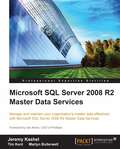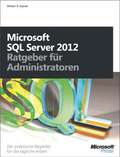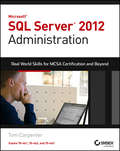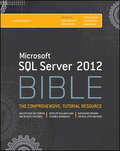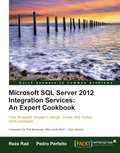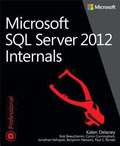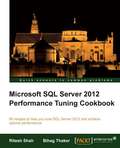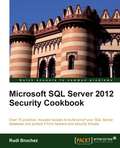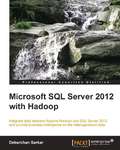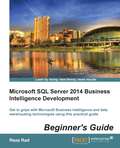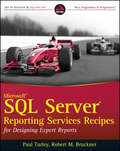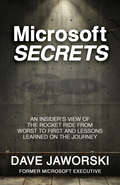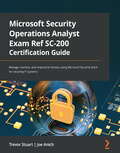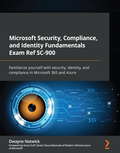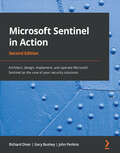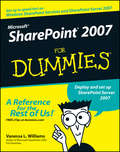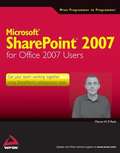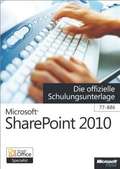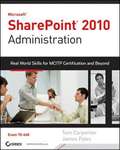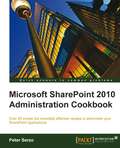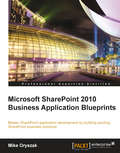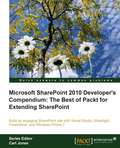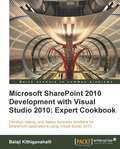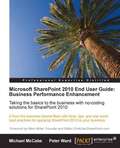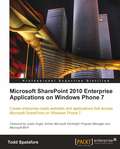- Table View
- List View
Microsoft SQL Server 2008 R2 Master Data Services
by Jeremy Kashel Tim KentThis is a practical, step-by-step guide to managing and maintaining your master data and improving data quality with Microsoft SQL Server 2008 R2 Master Data Services, with practical examples on how to use each feature.If you are a business and systems analyst or database administrator who wants to manage and maintain your business master data and improve data quality with Microsoft SQL Server Master Data Services, then this book is for you. A basic understanding of Microsoft SQL Server is required. However, knowledge of Master Data Services is not necessarily required.
Microsoft SQL Server 2012 - Ratgeber für Administratoren
by William R. StanekDieses Buch ist der kompakte Ratgeber für die tägliche Arbeit des Datenbankadministrators in Unternehmen jeder Größe. Es unterstützt Sie effizient bei der Verwaltung von Microsoft SQL Server 2012 und ist ideal für den Administrator-Arbeitsplatz.
Microsoft SQL Server 2012 Administration
by Tom CarpenterImplement, maintain, and repair SQL Server 2012 databasesAs the most significant update since 2008, Microsoft SQL Server 2012 boasts updates and new features that are critical to understand. Whether you manage and administer SQL Server 2012 or are planning to get your MCSA: SQL Server 2012 certification, this book is the perfect supplement to your learning and preparation. From understanding SQL Server's roles to implementing business intelligence and reporting, this practical book explores tasks and scenarios that a working SQL Server DBA faces regularly and shows you step by step how to handle them. Includes practice exams and coverage of exam objectives for those seeking MSCA: SQL Server 2012 certificationExplores the skills you'll need on the job as a SQL Server 2012 DBADiscusses designing and implementing database solutions Walks you through administrating, maintaining, and securing SQL Server 2012Addresses implementing high availability and data distributionIncludes bonus videos where the author walks you through some of the more difficult tasks expected of a DBAFeaturing hands-on exercises and real-world scenarios, this resource guides you through the essentials of implementing, maintaining, and repairing SQL Server 2012 databases.
Microsoft SQL Server 2012 Bible
by Patrick Leblanc Adam Jorgensen Aaron Nelson Jorge Segarra Jose ChinchillaHarness the powerful new SQL Server 2012Microsoft SQL Server 2012 is the most significant update to this product since 2005, and it may change how database administrators and developers perform many aspects of their jobs. If you're a database administrator or developer, Microsoft SQL Server 2012 Bible teaches you everything you need to take full advantage of this major release. This detailed guide not only covers all the new features of SQL Server 2012, it also shows you step by step how to develop top-notch SQL Server databases and new data connections and keep your databases performing at peak.The book is crammed with specific examples, sample code, and a host of tips, workarounds, and best practices. In addition, downloadable code is available from the book's companion web site, which you can use to jumpstart your own projects.Serves as an authoritative guide to Microsoft's SQL Server 2012 for database administrators and developersCovers all the software's new features and capabilities, including SQL Azure for cloud computing, enhancements to client connectivity, and new functionality that ensures high-availability of mission-critical applicationsExplains major new changes to the SQL Server Business Intelligence tools, such as Integration, Reporting, and Analysis ServicesDemonstrates tasks both graphically and in SQL code to enhance your learningProvides source code from the companion web site, which you can use as a basis for your own projectsExplores tips, smart workarounds, and best practices to help you on the jobGet thoroughly up to speed on SQL Server 2012 with Microsoft SQL Server 2012 Bible.
Microsoft SQL Server 2012 Integration Services: An Expert Cookbook
by Pedro Perfeito Reza RadThis book is written in a simple, easy to understand format with lots of screenshots and step-by-step explanations. If you are an SQL database administrator or developer looking to explore all the aspects of SSIS and need to use SSIS in the data transfer parts of systems, then this is the best guide for you. Basic understanding of working with SQL Server Integration Services is required.
Microsoft SQL Server 2012 Internals
by Kalen Delaney Paul S. Randal Conor Cunningham Bob Beauchemin Jonathan KehayiasDive deep inside the architecture of SQL Server 2012 Explore the core engine of Microsoft SQL Server 2012--and put that practical knowledge to work. Led by a team of SQL Server experts, you'll learn the skills you need to exploit key architectural features. Go behind the scenes to understand internal operations for creating, expanding, shrinking, and moving databases--whether you're a database developer, architect, or administrator. Discover how to: Dig into SQL Server 2012 architecture and configuration Use the right recovery model and control transaction logging Reduce query execution time through proper index design Track events, from triggers to the Extended Event Engine Examine internal structures with database console commands Transcend row-size limitations with special storage capabilities Choose the right transaction isolation level and concurrency model Take control over query plan caching and reuse
Microsoft SQL Server 2012 Performance Tuning Cookbook
by Ritesh ShahThis book has individual recipes and you can read it from cover to cover or dip into any recipe and get solution to a specific issue. Every recipe is based on a script/procedure explained with step-by-step instructions and screenshots. Concepts are illustrated for better understanding of why one solution performs better than another. SQL Server 2012 Performance Tuning Cookbook is aimed at SQL Server Database Developers, DBAs, and Database Architects who are working in any capacity to achieve optimal performance. However, basic knowledge of SQL Server is expected, but professionals who want to get hands-on with performance tuning and have not worked on tuning the SQL Server for performance will find this book helpful.
Microsoft SQL Server 2012 Security Cookbook
by Rudi BruchezEach recipe comprises step-by-step instructions followed by an analysis of what was done in each task and other useful information. The book is designed so that you can read it chapter by chapter, or look at the list of recipes and refer to them in no particular order. Each example comes with its expected output to make your learning even easier thus enabling you to successfully secure your SQL Server 2012 database. This book is for SQL Server administrators, developers, and consultants who want to secure their SQL Server database with cutting edge techniques for data and code encryption, user authentication and authorization, protection against brute force attacks, denial-of-service attacks, and SQL Injection, securing business intelligence, and more. Working knowledge of SQL Server is expected.
Microsoft SQL Server 2012 with Hadoop
by Debarchan SarkarThis book will be a step-by-step tutorial, which practically teaches working with big data on SQL Server through sample examples in increasing complexity.Microsoft SQL Server 2012 with Hadoop is specifically targeted at readers who want to cross-pollinate their Hadoop skills with SQL Server 2012 business intelligence and data analytics. A basic understanding of traditional RDBMS technologies and query processing techniques is essential.
Microsoft SQL Server 2014 Business Intelligence Development Beginner's Guide
by Reza RadIn Detail Take advantage of the real power behind the BI components of SQL Server 2014, Excel 2013, and SharePoint 2013 with this hands-on book. This book will give you a competitive advantage by helping you to quickly learn how to design and build BI system with Microsoft BI tools. This book starts with designing a data warehouse with dimensional modeling, and then looks at creating data models based on SSAS multidimensional and Tabular technologies. It will illustrate how to use SSIS for ETL, and MDS and DQS for data governance and data quality. The book is packed with real-world examples that will give you a good understanding of the BI and DW components of SQL Server 2014, Excel 2013, and SharePoint 2013. Approach Written in an easy-to-follow, example-driven format, there are plenty of step-by-step instructions to help get you started! The book has a friendly approach, with the opportunity to learn by experimenting. Who this book is for If you are a BI and Data Warehouse developer new to Microsoft Business Intelligence, and looking to get a good understanding of the different components of Microsoft SQL Server for Business Intelligence, this book is for you. It’s assumed that you will have some experience in databases systems and T-SQL. This book is will give you a good upshot view of each component and scenarios featuring the use of that component in Data Warehousing and Business Intelligence systems.
Microsoft SQL Server Reporting Services Recipes
by Paul Turley Robert M. BrucknerLearn to design more effective and sophisticated business reports While most users of SQL Server Reporting Services are now comfortable designing and building simple reports, business today demands increasingly complex reporting. In this book, top Reporting Services design experts have contributed step-by-step recipes for creating various types of reports. Written by well-known SQL Server Reporting Services experts, this book gives you the tools to meet your clients' needs
Microsoft Secrets: An Insider’s View of the Rocket Ride from Worst to First and Lessons Learned on the Journey
by Dave JaworskiA great deal has been written about Steve Jobs and Apple. Not nearly as much has been produced about Bill Gates and Microsoft, especially in the ten-year period that Dave Jaworski was at Microsoft. Microsoft was the company that drove the hardest and built the fastest. He was there during this rapid rise to the top. Dave kept meticulous notes and took lots of photos and documented the risks taken, the dreams shared, the lessons learned, the hopes realized, and the mistakes made. Many of the issues at the time are similar to issues confronting leaders in business today. All can learn from Microsoft’s past. Dave also details several secrets—some only his family knows. Some of these secrets were known to only a handful of people within the company at a time when it went through its explosive growth period: like the secret recipe for Coca-Cola or Colonel Sanders’ chicken recipe, these secrets were literally changing the competitive landscape in the technology industry and were rewriting the business rules of the day. Understanding these secrets and the thinking behind them can provide strategic insights and advantages to professionals and their businesses. Better still, they can help them define their own secrets to accelerate them past competitors and over hurdles to success.
Microsoft Security Operations Analyst Exam Ref SC-200 Certification Guide: Manage, monitor, and respond to threats using Microsoft Security Stack for securing IT systems
by Trevor Stuart Joe AnichRemediate active attacks to reduce risk to the organization by investigating, hunting, and responding to threats using Microsoft Sentinel, Microsoft Defender for Cloud, and Microsoft 365 DefenderKey FeaturesDetect, protect, investigate, and remediate threats using Microsoft Defender for endpointExplore multiple tools using the M365 Defender Security CenterGet ready to overcome real-world challenges as you prepare to take the SC-200 examBook DescriptionSecurity in information technology has always been a topic of discussion, one that comes with various backgrounds, tools, responsibilities, education, and change! The SC-200 exam comprises a wide range of topics that introduce Microsoft technologies and general operations for security analysts in enterprises. This book is a comprehensive guide that covers the usefulness and applicability of Microsoft Security Stack in the daily activities of an enterprise security operations analyst.Starting with a quick overview of what it takes to prepare for the exam, you'll understand how to implement the learning in real-world scenarios. You'll learn to use Microsoft's security stack, including Microsoft 365 Defender, and Microsoft Sentinel, to detect, protect, and respond to adversary threats in your enterprise. This book will take you from legacy on-premises SOC and DFIR tools to leveraging all aspects of the M365 Defender suite as a modern replacement in a more effective and efficient way.By the end of this book, you'll have learned how to plan, deploy, and operationalize Microsoft's security stack in your enterprise and gained the confidence to pass the SC-200 exam.What you will learnDiscover how to secure information technology systems for your organizationManage cross-domain investigations in the Microsoft 365 Defender portalPlan and implement the use of data connectors in Microsoft Defender for CloudGet to grips with designing and configuring a Microsoft Sentinel workspaceConfigure SOAR (security orchestration, automation, and response) in Microsoft SentinelFind out how to use Microsoft Sentinel workbooks to analyze and interpret dataSolve mock tests at the end of the book to test your knowledgeWho this book is forThis book is for security professionals, cloud security engineers, and security analysts who want to learn and explore Microsoft Security Stack. Anyone looking to take the SC-200 exam will also find this guide useful. A basic understanding of Microsoft technologies and security concepts will be beneficial.
Microsoft Security, Compliance, and Identity Fundamentals Exam Ref SC-900: Familiarize yourself with security, identity, and compliance in Microsoft 365 and Azure
by Dwayne Natwick Sonia CuffUnderstand the fundamentals of security, compliance, and identity solutions across Microsoft Azure, Microsoft 365, and related cloud-based Microsoft servicesKey FeaturesGrasp Azure AD services and identity principles, secure authentication, and access managementUnderstand threat protection with Microsoft 365 Defender and Microsoft Defender for Cloud security managementLearn about security capabilities in Microsoft Sentinel, Microsoft 365 Defender, and Microsoft IntuneBook DescriptionCloud technologies have made building a defense-in-depth security strategy of paramount importance. Without proper planning and discipline in deploying the security posture across Microsoft 365 and Azure, you are compromising your infrastructure and data. Microsoft Security, Compliance, and Identity Fundamentals is a comprehensive guide that covers all of the exam objectives for the SC-900 exam while walking you through the core security services available for Microsoft 365 and Azure.This book starts by simplifying the concepts of security, compliance, and identity before helping you get to grips with Azure Active Directory, covering the capabilities of Microsoft's identity and access management (IAM) solutions. You'll then advance to compliance center, information protection, and governance in Microsoft 365. You'll find out all you need to know about the services available within Azure and Microsoft 365 for building a defense-in-depth security posture, and finally become familiar with Microsoft's compliance monitoring capabilities.By the end of the book, you'll have gained the knowledge you need to take the SC-900 certification exam and implement solutions in real-life scenarios.What you will learnBecome well-versed with security, compliance, and identity principlesExplore the authentication, access control, and identity management capabilities of Azure Active DirectoryUnderstand the identity protection and governance aspects of Azure and Microsoft 365Get to grips with the basic security capabilities for networks, VMs, and dataDiscover security management through Microsoft Defender for CloudWork with Microsoft Sentinel and Microsoft 365 DefenderDeal with compliance, governance, and risk in Microsoft 365 and AzureWho this book is forThis book is for cloud security engineers, Microsoft 365 administrators, Azure administrators, and anyone in between who wants to get up to speed with the security, compliance, and identity fundamentals to achieve the SC-900 certification. A basic understanding of the fundamental services within Microsoft 365 and Azure will be helpful but not essential.
Microsoft Sentinel in Action: Architect, design, implement, and operate Microsoft Sentinel as the core of your security solutions, 2nd Edition
by John Perkins Richard Diver Gary BusheyLearn how to set up, configure, and use Microsoft Sentinel to provide security incident and event management services for your multi-cloud environmentKey FeaturesCollect, normalize, and analyze security information from multiple data sourcesIntegrate AI, machine learning, built-in and custom threat analyses, and automation to build optimal security solutionsDetect and investigate possible security breaches to tackle complex and advanced cyber threatsBook DescriptionMicrosoft Sentinel is a security information and event management (SIEM) tool developed by Microsoft that helps you to integrate cloud security and artificial intelligence (AI). This book will enable you to implement Microsoft Sentinel and understand how it can help detect security incidents in your environment with integrated AI, threat analysis, and built-in and community-driven logic.The book begins by introducing you to Microsoft Sentinel and Log Analytics. You'll then get to grips with data collection and management, before learning how to create effective Microsoft Sentinel queries to detect anomalous behaviors and activity patterns. Moving ahead, you'll learn about useful features such as entity behavior analytics and Microsoft Sentinel playbooks along with exploring the new bi-directional connector for ServiceNow. As you progress, you'll find out how to develop solutions that automate responses needed to handle security incidents. Finally, you'll grasp the latest developments in security, discover techniques to enhance your cloud security architecture, and explore how you can contribute to the security community.By the end of this Microsoft Sentinel book, you'll have learned how to implement Microsoft Sentinel to fit your needs and be able to protect your environment from cyber threats and other security issues.What you will learnImplement Log Analytics and enable Microsoft Sentinel and data ingestion from multiple sourcesGet to grips with coding using the Kusto Query Language (KQL)Discover how to carry out threat hunting activities in Microsoft SentinelConnect Microsoft Sentinel to ServiceNow for automated ticketingFind out how to detect threats and create automated responses for immediate resolutionUse triggers and actions with Microsoft Sentinel playbooks to perform automationsWho this book is forIf you are an IT professional with prior experience in other Microsoft security products and Azure and are now looking to expand your knowledge to incorporate Microsoft Sentinel, then this book is for you. Security experts using an alternative SIEM tool who want to adopt Microsoft Sentinel as an additional service or as a replacement will also find this book useful.
Microsoft SharePoint 2007 For Dummies
by Vanessa L. WilliamsMicrosoft SharePoint now has a 10 percent share of the portal market, and the new release, which features enhanced integration with Office 2007, is sure to give SharePoint a boostOffers clear instructions and soup-to-nuts coverage of this complex product, focusing instead on practical solutions to real-world SharePoint challengesFeatures tips, tricks, and techniques for administrators who need to install and configure a SharePoint portal as well as ordinary users who need to populate and maintain the portal and use it for collaborative projectsTopics covered include setting up a SharePoint portal, matching SharePoint to business needs, managing portal content, branding, collaborating on SharePoint sites, using a portal to improve employee relations and marketing, putting expense reports and other interactive forms on a portal, and monitoring and backing up SharePoint
Microsoft SharePoint 2007 for Office 2007 Users
by Martin ReidAimed at end users who face the daunting task of mastering MOSS 2007 in the enterprise business environment, this book shows you how to make effective use of what can be a confusing array of features. You?ll review how SharePoint is central to the Microsoft Office platform because organizations use it to organize workflow, integrate Office documents with line of business applications, provide search capabilities across all types of documents and data, and distribute these tools internally and externally on Web sites for end users. Plus, the book offers you well-designed examples and explanations that can be easily applied in real-world situations. Martin WP Reid (Belfast, Ireland) is an analyst for The Queens University of Belfast, Northern Ireland. He is the author and technical editor of more than a dozen technical books. He is a regular contributor to the Microsoft Office SharePoint blog Get the Point (http://sharepoint. microsoft. com/blogs/getthepoint )
Microsoft SharePoint 2010 - Die offizielle Schulungsunterlage (77-886)
by Microsoft PressDie offizielle Schulungsunterlage zu SharePoint 2010 wurde von Microsoft für alle Anwender entwickelt, die im Rahmen einer Trainingsmaßnahme den effizienten Umgang mit Microsoft SharePoint erlernen möchten. Durch den ausgereiften didaktischen Aufbau lernen Sie in übersichtlichen Lektionen die Arbeitstechniken kennen, mit deren Hilfe Sie die typischen Anforderungen beim beruflichen Einsatz von SharePoint 2010 meistern. Klare Lernziele weisen Ihnen den Weg, leicht nachvollziehbare Schritt-für-Schritt-Anleitungen mit reichhaltiger Bebilderung führen Sie durch die Arbeitsschritte und Wiederholungsfragen stellen sicher, dass Sie den Stoff verstanden haben. Gleichzeitig stellt diese Schulungsunterlage eine solide Basis für die Vorbereitung auf die Microsoft Office Specialist (MOS)-Prüfung 77-886 dar.
Microsoft SharePoint 2010 Administration
by James Pyles Tom CarpenterDelivers the information that SharePoint 2010 administrators in the field need mostThis book shows you how to design, deploy, and implement a SharePoint 2010 environment, providing practical skills and real-world techniques and scenarios you'll be able to apply on the job. You'll not only thoroughly learn SharePoint 2010, but you'll also get up to speed on business continuity and solutions. In addition, those preparing for the MCITP: SharePoint 2010 Administration certification exam 70-668 will find thorough coverage of all exam objectives.Shows you how to design, deploy, administer, and maintain a SharePoint Server 2010 infrastructureGuides readers through preparation for Microsoft SharePoint 2010, Administrator (Exam 70-668)Includes techniques and instructional videos from industry expert and lead author, Tom Carpenter, a well-known author and instructor.Companion CD includes over an hour of video instruction on some of the more difficult topics, as well as practice exams, flashcards, and moreIf you're preparing for MCITP exam 70-668, as well as a career as a SharePoint 2010 administrator, this is a book you'll want.
Microsoft SharePoint 2010 Administration Cookbook
by Peter SerzoMicrosoft SharePoint 2010 Administration Cookbook contains step-by-step instructions for SharePoint administrators to gain control of their SharePoint environment. The book is designed so that you can refer to it chapter by chapter, or you can look at the list of recipes and read those that interest you in no particular order.If you are a SharePoint Administrator looking for solutions to the many problems faced while managing SharePoint, then this book is for you. It is written for SharePoint administrators who are either already working on SharePoint, or have recently started working and eager to learn more about SharePoint administration. You need to have some basic knowledge of SharePoint in order to follow the recipes in this book.
Microsoft SharePoint 2010 Business Application Blueprints
by Mike OryszakThe hands-on example solutions in this book are based on fictitious business development briefs, and they illustrate practical ways of using SharePoint in various business scenarios. A chapter is dedicated to each example SharePoint solution covering step-by-step instructions for building the SharePoint solutions, aided by the extensive use of screenshots. This book is for SharePoint developers, consultants, and administrators who want to build a range of SharePoint solutions that extend the SharePoint platform, and see how to apply the many available SharePoint features in different scenarios.
Microsoft SharePoint 2010 Developer’s Compendium: The Best of Packt for Extending SharePoint
by Gastón C. Hillar Yaroslav Pentsarskyy Balaji Kithiganahalli"Microsoft SharePoint 2010 Developer's Compendium: The Best of Packt for Extending SharePoint" takes a less discussion, more value approach to helping you learn all that you can about extending SharePoint. A medley of a total of five Packt books, each chapter has its own unique style so that you can learn not only from content written in a step by step tutorial style, but also from handbook and cookbook chapters. If you are a developer who would like to enhance your knowledge of SharePoint development to create sites with great user experience, don't miss "Microsoft SharePoint 2010 Developer's Compendium: The Best of Packt for Extending SharePoint". You should already be comfortable with general SharePoint development practices, though prior experience with PowerShell, Visual Studio, Silverlight and Windows 7 Phone is not a necessity.
Microsoft SharePoint 2010 Development with Visual Studio 2010 Expert Cookbook
by Balaji KithiganahalliThis book follows a step-by-step approach to learning the building blocks of SharePoint application development. This book focuses on SharePoint 2010 development using Visual studio 2010. The book provides a hands-on approach to solving problems and creating business solutions for enhancing SharePoint 2010 environment. This book is for .NET developers to understand the building blocks for SharePoint 2010. Although the book can be used by beginners, it is recommended to have understanding of the previous versions of SharePoint. Developing SharePoint solutions needs solid understanding of ASP.NET architecture. The book assumes that the reader is familiar with ASP.NET technology and development concepts.
Microsoft SharePoint 2010 End User Guide: Business Performance Enhancement
by Peter Ward Michael MccabeAn essential hands-on guide, this book describes functionality, ideas and terminology related to SharePoint and applies the knowledge to enhance your business. This is not a heavy technical book for the professional IT department power user, weighed down with technical jargon and techniques, but a tutorial full of great advice and short cuts to SharePoint's functionality, where the authors remember all the tough stuff so you don't have too. While other books will tell you what SharePoint can do from a technical standpoint and may leave you wondering if the product is appropriate for your day-to-day needs, this guide will provide you with the information and hands on tools so you can immediately apply solutions to your work environment. If you are a SharePoint 2010 end user and you want to take back control of your workday and Inbox by applying your knowledge of SharePoint, then this book is ideal for you. By using SharePoint to complement your Office desktop tools, this book will be a tremendous aid if you are an end user willing to invest a few hours of reading to become highly productive and efficient in working with information on a day to day basis. You should be comfortable with the basic functionality of Outlook, other Office applications, and basic web page functions. No prior knowledge of SharePoint is required.
Microsoft SharePoint 2010 Enterprise Applications on Windows Phone 7
by Todd SpataforeThis book is a focused tutorial that shows you how to create enterprise-ready websites and applications that access Microsoft SharePoint Server on Windows Phone 7. This book focuses on SharePoint 2010; however, some of the concepts and explanations will also apply to SharePoint 2007. If you are a .NET developer who wants to create enterprise-ready websites and applications that access SharePoint Server on Windows Phone 7, then this book is for you. You should have a basic knowledge of Windows 7 Phone and SharePoint Server. This book also assumes some knowledge of C#, managed code in general, and a basic level of familiarity with Visual Studio.
